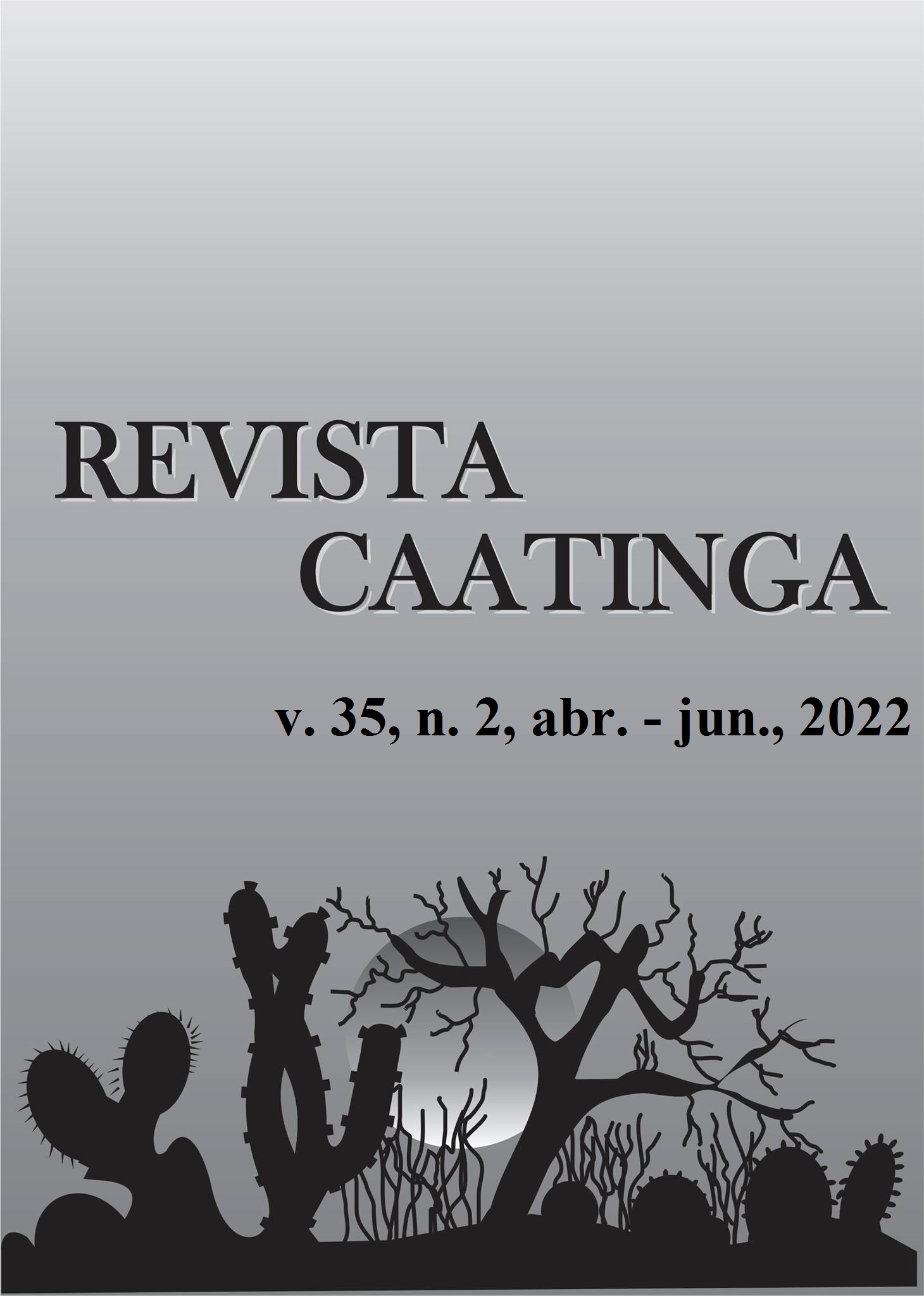GROWTH ANALYSIS AND PHOTOASSIMILATED PARTITION IN ARROWROOT PLANTS IN ORGANIC CROP SYSTEM
DOI:
https://doi.org/10.1590/1983-21252022v35n223rcKeywords:
Maranta arundinacea L. Growth stages. Leaf area index. Cultivars.Abstract
Arrowroot (Maranta arundinaceae), a traditional plant used to extract medicinal starch that is gluten-free and of excellent nutritional quality, is understudied for its growth and development in the organic crop system. The objective of this study was to evaluate the growth and photoassimilate partitioning in plants of two cultivars, Comum and Seta arrowroot. The design was performed in random blocks with four repetitions. At 57 days after planting (DAP), the plants were collected at regular intervals of 25 days throughout the crop cycle, and the dry mass was determined. Growth analysis was performed using the primary data. The cultivars Comum and Seta show maximum absolute growth rates of 10.51 and 12.42 g plant-1 day-1 and the maximum leaf area index (LAI) of 18.74 and 14.62, as recorded for 216 and 205 DAP, respectively. The higher absolute growth rate and higher growth of arrowroot plants in a shorter time indicate greater precocity of cultivar Seta compared to Comum. The photoassimilate partitioning is balanced between the aerial parts and rhizomes at the end of the cycle. Both cultivars can be recommended for the organic crop system in the Zona da Mata region of Minas Gerais.
Downloads
References
AMANTE, P. R. et al. Benefits and possible food applications of arrowroot (Maranta Arundinaceae L.). Journal of Culinary Science and Technology, 18: 1-9, 2020.
BENINCASA, M. M. P. Análise de crescimento de plantas: noções básicas. 2. ed. Jaboticabal, SP: FUNEP, 2003. 42 p.
BRITO, V. et al. Phenological stages of arrowroot (Maranta arundinacea L.) according to the Biologische Bundesanstalt Bundessortenamt und Chemische Industrie scale. Annals of Applied Biology, 175: 119-128, 2019.
CONCEIÇÃO, M. K.; LOPES, N. F.; FORTES, G. R. L. Partição de matéria seca entre órgãos de batata-doce (Ipomoea batatas (L.) Lam), cultivares abóbora e da costa. Revista Brasileira Agrociência, 10: 313-316, 2004.
FERNANDES, A. M. et al. Crescimento, acúmulo e distribuição de matéria seca em cultivares de batata na safra de inverno. Pesquisa Agropecuária Brasileira, 45: 826-835, 2010.
FERRARI, T. B.; LEONEL, M.; SARMENTO, S. B. S. Características dos rizomas e do amido de araruta (Maranta arundinacea) em diferentes estádios de desenvolvimento da planta. Brazilian Journal of Food Technology, 8: 93-98, 2005.
GUILHERME, D. O. et al. Características fenológicas da araruta (Maranta arundinaceae L.) para cultivo a campo. Congresso Online de Agronomia. Convibra, 4: 1-8, 2016.
GUILHERME, D. O. et al. Starch valorization from corm, tuber, rhizome, and root crops: The Arrowroot (Maranta arundinacea L.) case. In: CLERICI, M. T. S.; SCHMIELE, M. (Eds.). Starches for food application: Chemical, technological and Health Properties. Cambridge: Academic Press. 2019, p. 167–222.
LEONEL, M.; CEREDA, M. P. Caracterização físico-química de algumas tuberosas amiláceas. Food Science and Technology, 22: 65-69, 2002.
MARTINAZZO, E. G. et al. Análise de crescimento e partição de assimilados em plantas de tomateiro cv. Micro-Tom submetidas ao nitrogênio e piraclostrobina. Semina: Ciências Agrárias, 36: 3001-3012, 2015.
OLIVEIRA, F. L.; ARAÚJO, A. P.; GUERRA, J. G. M. Crescimento e acumulação de nutrientes em plantas de taro sob níveis de sombreamento artificial. Horticultura Brasileira, 29: 292-298, 2011.
PEREIRA, E. D. Crescimento e acúmulo de macronutrientes em araruta (Maranta arundinacea L.) ao longo do ciclo de cultivo. 2019. 43 f. Dissertação (Mestrado em Fitotecnia) - Universidade Federal de Viçosa, Viçosa, 2019.
RASBAND, W.S. ImageJ. 2016. Disponível em: http://imagej.nih.gov/ij/. Acesso em: 01 mar. 2017.
SANTOS, J. S.; CEREDA, M. P.; GUILHERME, D. O. Crescimento e desenvolvimento de genótipos de Araruta em função de doses crescentes de fósforo. Revista Agrária Acadêmica, 2: 118-124, 2019.
SOUZA, D. C. et al. Characterization of arrowroot starch in different agronomic managements. Revista Ceres, 66: 323-332, 2019a.
SOUZA, D. C. et al. Productivity of rhizomes and starch quantification in cultures of different vegetative propagules of arrowroot. Journal of Agricultural Science, 11: 419-425, 2019b.
TAIZ, L. et al. Fisiologia e desenvolvimento vegetal. 6.ed. Porto Alegre, RS: Artmed, 2017. 858 p.
VIDIGAL, S. M.; PUIATTI, M.; SEDIYAMA, M. A. N. Análise de crescimento e partição de fotoassimilados em plantas de abóbora híbrida Tetsukabuto submetidas a doses de nitrogênio. Científica, 49: 42-50, 2021.
Downloads
Published
Issue
Section
License
Os Autores que publicam na Revista Caatinga concordam com os seguintes termos:
a) Os Autores mantêm os direitos autorais e concedem à revista o direito de primeira publicação, com o trabalho simultaneamente licenciado sob a Licença Creative Commons do tipo atribuição CC-BY, para todo o conteúdo do periódico, exceto onde estiver identificado, que permite o compartilhamento do trabalho com reconhecimento da autoria e publicação inicial nesta revista, sem fins comerciais.
b) Os Autores têm autorização para distribuição não-exclusiva da versão do trabalho publicada nesta revista (ex.: publicar em repositório institucional ou como capítulo de livro), com reconhecimento de autoria e publicação inicial nesta revista.
c) Os Autores têm permissão e são estimulados a publicar e distribuir seu trabalho online (ex.: em repositórios institucionais ou na sua página pessoal) a qualquer ponto antes ou durante o processo editorial, já que isso pode gerar alterações produtivas, bem como aumentar o impacto e a citação do trabalho publicado (Veja O Efeito do Acesso Livre).







